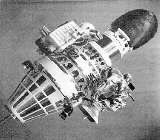
Luna 4
Encyclopedia
Luna 4 was the USSR
's first successful spacecraft of their "second generation" Luna program. The spacecraft, rather than being sent on a straight trajectory toward the Moon
, was placed first in a low Earth orbit (167 to 182 km altitude) and then the rocket stage reignited to send it on a curving path towards the Moon.
Luna 4, the second attempt of this program, achieved the desired trajectory but a failure to make a required midcourse correction resulted in it missing the Moon by 8336.2 km at 13:25 UT on April 5, 1963. It then entered a barycentric
90,000 × 700,000 km Earth orbit. The intended mission of the probe is not known, it was speculated the probe was designed to land on the Moon with an instrument package based on the trajectory and on the later attempted landings of the Luna 5
and Luna 6
spacecraft and successful landing of Luna 9
. (A lecture program entitled "Hitting the Moon" was scheduled to be broadcast on Radio Moscow at 7:45 p.m. the evening of April 5 but was cancelled.) The spacecraft transmitted at 183.6 MHz at least until April 6.
Soviet Union
The Soviet Union , officially the Union of Soviet Socialist Republics , was a constitutionally socialist state that existed in Eurasia between 1922 and 1991....
's first successful spacecraft of their "second generation" Luna program. The spacecraft, rather than being sent on a straight trajectory toward the Moon
Moon
The Moon is Earth's only known natural satellite,There are a number of near-Earth asteroids including 3753 Cruithne that are co-orbital with Earth: their orbits bring them close to Earth for periods of time but then alter in the long term . These are quasi-satellites and not true moons. For more...
, was placed first in a low Earth orbit (167 to 182 km altitude) and then the rocket stage reignited to send it on a curving path towards the Moon.
Luna 4, the second attempt of this program, achieved the desired trajectory but a failure to make a required midcourse correction resulted in it missing the Moon by 8336.2 km at 13:25 UT on April 5, 1963. It then entered a barycentric
Barycentric coordinates (astronomy)
In astronomy, barycentric coordinates are non-rotating coordinates with origin at the center of mass of two or more bodies.The barycenter is the point between two objects where they balance each other. For example, it is the center of mass where two or more celestial bodies orbit each other...
90,000 × 700,000 km Earth orbit. The intended mission of the probe is not known, it was speculated the probe was designed to land on the Moon with an instrument package based on the trajectory and on the later attempted landings of the Luna 5
Luna 5
Luna 5 was an unmanned space mission of the Luna program, also called Lunik 5. It was designed to continue investigations of a lunar soft landing. The retrorocket system failed, and the spacecraft impacted the lunar surface at the Sea of Clouds....
and Luna 6
Luna 6
Luna 6 was an unmanned space mission of the Luna program, also called Lunik 6. Luna 6 was intended to travel to the Moon, but, because a mid-course correction failed, it missed the Moon by 159,612.8 km....
spacecraft and successful landing of Luna 9
Luna 9
Luna 9 was an unmanned space mission of the Soviet Union's Luna program. On February 3, 1966 the Luna 9 spacecraft was the first spacecraft to achieve a soft landing on any planetary body other than Earth and to transmit photographic data to Earth.The automatic lunar station that achieved the...
. (A lecture program entitled "Hitting the Moon" was scheduled to be broadcast on Radio Moscow at 7:45 p.m. the evening of April 5 but was cancelled.) The spacecraft transmitted at 183.6 MHz at least until April 6.

